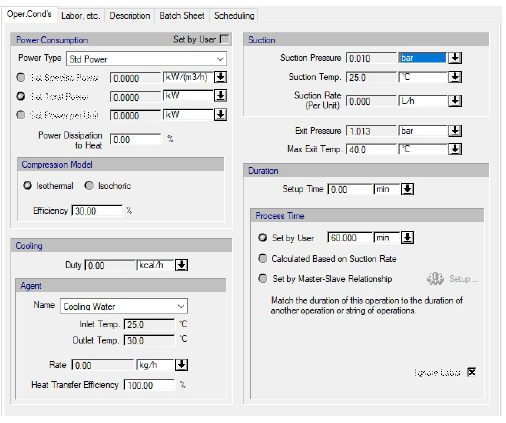

The following table shows a brief description of the variables appearing in this tab. The table also displays their default values and their generally acceptable range:
|
Variable |
Default Value |
Range |
|
|
||
|
○ Power Consumption Set by User |
No |
Yes/No |
|
○ Power Type |
<Std Power> |
Any Power Type |
|
◙ Specific Power (kW/(m3/h) |
0.0 |
Positive |
|
◙ Total Power (kW) |
0.0 |
Positive |
|
◙ Power Per Unit (kW) |
0.0 |
Positive |
|
○ Power Dissipation into Heat (%) |
0.0 |
[0,100) |
|
○ Efficiency (%) |
30.0 |
(0,100) |
|
● Cooling Duty (kcal/h) |
0.0 |
Positive |
|
○ Cooling Agent Name |
<Cooling Water> |
Any Cooling Agent |
|
● Cooling Agent Inlet Temp. (oC) |
25.0 |
Positive |
|
● Cooling Agent Outlet Temp. (oC) |
30.0 |
Positive |
|
● Cooling Agent Rate (kg/h) |
0.0 |
Positive |
|
● Suction Pressure (atm) |
0.0 |
Positive |
|
● Suction Temp. (oC) |
25.0 |
Positive |
|
● Suction Rate (per Unit) (L/h) |
0.0 |
Positive |
|
● Exit Pressure (atm) |
1.0 |
Positive |
|
○ Max Exit Temp. (oC) |
40.0 |
Positive |
|
○ Setup Time (min) |
0.0 |
Positive |
|
◙ Process Time (min) |
240.0 |
Positive |
|
○ Ignore Labor? |
Yes |
Yes/No |
Symbol Key: ○ User-specified value (always input); ● Calculated value (always output); ◙ Sometimes input, sometimes output
The following list describes the available specification choices in this tab; for more details on how these are implemented, see Pumping (by Vacuum Pump): Modeling Calculations.
•Power consumption...
Check this box to specify the total power or specific power (which is defined as the total power consumption divided by the total suction rate) or power per unit. If this box is not checked, then the power consumption is calculated based on the selected compression model (see below).
•Compression Model...
You may either select isothermal compression or isochoric compression. Compression in a liquid ring vacuum pump is isothermal, while compression in a roots vacuum pump is isochoric..
•Duration Options...
In Rating Mode, you can set the process time (and setup time) or allow the process time to be calculated based on the suction rate or allow the duration to match exactly the duration of another operation (either in the same procedure or in another procedure). In Design mode, you must either specify the process time (and setup time) or allow the duration to match exactly the duration of another operation (either in the same procedure or in another procedure), in order for the program to calculate the required power (per cycle and per unit).
If you choose to match the duration of this operation with the duration of another operation, you introduce a master-slave relationship between the two operations. The program will match the setup-time, the process time and the turnaround time of this operation (the ‘slave’) with the corresponding times of the reference operation (the ‘master’ operation). For more on master-slave relationship, see The Scheduling Tab.